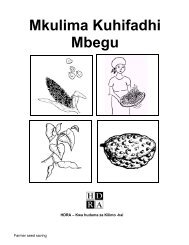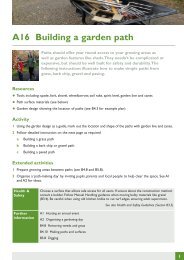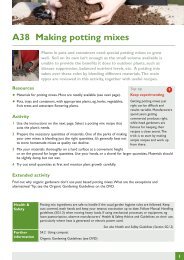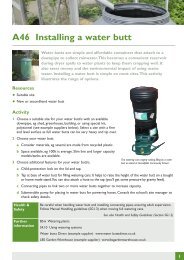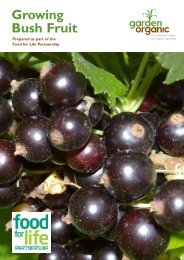Download PDF - Garden Organic
Download PDF - Garden Organic
Download PDF - Garden Organic
Create successful ePaper yourself
Turn your PDF publications into a flip-book with our unique Google optimized e-Paper software.
http://www.gardenorganic.org.uk/organicweeds<br />
favoured by conservation tillage (Rothwell et al., 2005). Intense tillage can reduce<br />
earthworm populations due to reductions in food supply, damage to soil burrows and<br />
direct injury.<br />
Tillage is often divided into three forms primary, secondary and tertiary (Forcella &<br />
Burnside, 1994), but there are other cultivations that do not fall into these categories.<br />
Primary tillage<br />
Primary tillage is the principal method chosen for cultivation prior to crop<br />
establishment. The main choice is between ploughing or non-ploughing (reduced or<br />
minimal cultivation, conservation tillage, no-till, direct-drilling etc) systems of soil<br />
management. Machinery is now available that will work a stubble down to a seedbed<br />
in a single pass. Daly & Stevenson (1990) posed the question “to what degree can<br />
surface cultivation be used to establish a relatively sterile surface layer and how often<br />
should this be alternated with ploughing”. Ploughing is seen as a method by which<br />
weed seeds can be buried below the depth from which they are capable of<br />
germinating, and it is sometimes said that ploughing is needed only to bury the weed<br />
problem. But this short-term solution to poor weed control in a previous crop often<br />
leads to long term problem due to the persistence of the buried weed seeds in the soil<br />
seedbank. Nevertheless, ploughing has been used in the UK since before the Romans<br />
to deal with weeds and trash from the previous crop (Elliot et al., 1977). It remains<br />
the basic tool of soil cultivation although changes to the design have made it more<br />
efficient. The introduction of the reversible plough in the 19 th century was a major<br />
development. The substitution of the tractor for the horse in the 20 th century allowed<br />
an increased number of furrows to be turned at each pass and the speed and depth of<br />
operations were also increased. But in recent years reduced cultivation systems that<br />
avoid the use of the plough have found favour with farmers.<br />
Primary tillage has been the subject of considerable research in comparing the merits<br />
of ploughing with reduced tillage systems for weed management (Forcella &<br />
Burnside, 1994). The concept of direct drilling crops without resorting to ploughing<br />
became popular after the development of the non-residual herbicides paraquat and<br />
diquat. Recently, there has been renewed interest primarily out of concern for soil<br />
conservation, and in particular to prevent erosion (Buhler, 1995). However, as with<br />
the herbicide-based system, wind disseminated and perennial weed species can<br />
increase (McLaughlin & Mineau, 1995), and volunteer weeds are also likely to be a<br />
problem (Buhler, 1995). Nevertheless, non-inversion tillage keeps fresh weed seeds<br />
near the soil surface where shallow cultivations can be directed to depleting seed<br />
numbers (Melander & Rasmussen, 2000).<br />
Working soil to a depth of 10 cm is expected to carry 20 to 40% of seeds to between 5<br />
and 10 cm below the soil surface (Cussans, 1966). In a no-tillage system, 60% of the<br />
weed seeds in the top 19 cm of soil were in the surface 1 cm of soil. Where the soil<br />
had been chisel ploughed 30% of seeds were in the top 1 cm of soil and seed<br />
concentration then declined linearly with depth. Where mouldboard ploughing had<br />
taken place there was a uniform distribution of weed seeds in the top 19 cm of soil<br />
(Yenish et al., 1992). In a comparison of cultivation regimes in corn and cornsoybean<br />
rotations over a 3 year period, the weed seeds in the top 10 cm of soil<br />
following non-tillage, chisel ploughing and moldboard ploughing represented 74, 59<br />
October 2007 2




